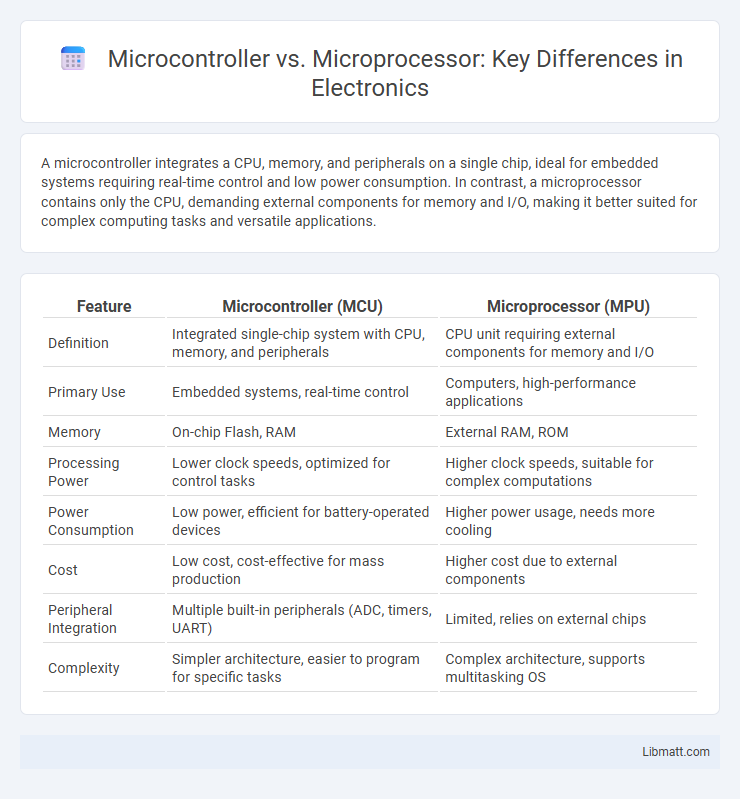A microcontroller integrates a CPU, memory, and peripherals on a single chip, ideal for embedded systems requiring real-time control and low power consumption. In contrast, a microprocessor contains only the CPU, demanding external components for memory and I/O, making it better suited for complex computing tasks and versatile applications.
Table of Comparison
| Feature | Microcontroller (MCU) | Microprocessor (MPU) |
|---|---|---|
| Definition | Integrated single-chip system with CPU, memory, and peripherals | CPU unit requiring external components for memory and I/O |
| Primary Use | Embedded systems, real-time control | Computers, high-performance applications |
| Memory | On-chip Flash, RAM | External RAM, ROM |
| Processing Power | Lower clock speeds, optimized for control tasks | Higher clock speeds, suitable for complex computations |
| Power Consumption | Low power, efficient for battery-operated devices | Higher power usage, needs more cooling |
| Cost | Low cost, cost-effective for mass production | Higher cost due to external components |
| Peripheral Integration | Multiple built-in peripherals (ADC, timers, UART) | Limited, relies on external chips |
| Complexity | Simpler architecture, easier to program for specific tasks | Complex architecture, supports multitasking OS |
Introduction to Microcontrollers and Microprocessors
Microcontrollers integrate a CPU, memory, and peripherals on a single chip, designed for embedded systems and real-time applications. Microprocessors consist primarily of a CPU, relying on external components for memory and input/output functions, making them suitable for complex computing tasks. The architecture of microcontrollers emphasizes compactness and control, while microprocessors focus on processing power and flexibility.
Core Architecture Differences
Microcontrollers integrate a CPU core, memory, and peripherals on a single chip, optimized for embedded applications requiring real-time control and low power consumption. Microprocessors feature a more complex core architecture, emphasizing higher processing power and speed, relying on external components for memory and I/O functions. Understanding these core architecture differences helps you select the right device for efficient system design and optimized performance.
Key Functionalities and Applications
Microcontrollers integrate a CPU with memory and programmable input/output peripherals on a single chip, making them ideal for embedded systems such as automotive controls, home appliances, and IoT devices. Microprocessors consist primarily of a CPU and require external components like memory and I/O interfaces, providing higher processing power suited for applications like personal computers, servers, and smartphones. The choice between microcontroller and microprocessor depends on factors like real-time control requirements, power consumption, and computational complexity.
Performance and Processing Power
Microprocessors deliver higher performance and processing power with powerful CPUs capable of executing complex instructions and handling multitasking efficiently, making them ideal for high-end computing applications. Microcontrollers integrate a CPU with memory and peripherals on a single chip, optimized for control-oriented tasks with lower clock speeds and limited processing power suited for embedded systems. The choice depends on application requirements: microprocessors prioritize speed and computational capabilities, while microcontrollers balance performance with real-time control and energy efficiency.
Power Consumption and Efficiency
Microcontrollers typically consume less power than microprocessors due to their integrated design combining CPU, memory, and peripherals on a single chip, making them highly efficient for embedded and battery-powered applications. Microprocessors, designed for higher performance and complex computing tasks, often require more power and additional external components. Choosing a microcontroller can optimize your system's power consumption and operational efficiency, especially in energy-sensitive environments.
Integrated Peripherals and Memory
Microcontrollers feature integrated peripherals such as ADCs, timers, and communication interfaces, along with on-chip memory (RAM and Flash) optimized for embedded control tasks. Microprocessors rely on external peripherals and memory modules, providing greater flexibility and higher processing power but increased system complexity. Your choice depends on whether you need a compact, self-contained system or a high-performance, customizable computing platform.
Cost and Availability
Microcontrollers generally cost less than microprocessors due to their integrated components, making them more affordable for embedded system applications. Availability of microcontrollers is higher in bulk for specific tasks, while microprocessors are often sourced for high-performance computing needs and may be less accessible in compact, low-cost projects. Your choice depends on budget constraints and the required computational complexity.
Programming and Development Environment
Microcontrollers integrate both the processor and memory, enabling simpler, more compact programming suited for embedded systems, while microprocessors rely on external components requiring a more complex development environment. You will find microcontroller programming often uses specialized IDEs with direct hardware access, whereas microprocessor development typically involves operating systems and high-level languages for versatile applications. Understanding these distinctions is crucial for selecting the right platform based on your project's programming and development environment needs.
Popular Examples and Use Cases
Microcontrollers like the Arduino Uno and PIC16F877A are popular in embedded systems, home automation, and IoT devices due to their integrated memory and peripherals. Microprocessors such as Intel Core i7 and AMD Ryzen excel in personal computers, laptops, and servers, providing high processing power for complex applications. Your choice depends on whether you need a compact, cost-efficient solution with real-time control or high-performance computing capabilities.
Choosing the Right Solution for Your Project
Selecting the right solution between a microcontroller and microprocessor depends on the project's complexity, power consumption, and integration needs. Microcontrollers integrate memory, peripherals, and input/output ports on a single chip, ideal for embedded systems requiring low power and cost-effectiveness. Microprocessors offer higher processing power and flexibility with external components, suitable for complex applications like multimedia processing or operating systems.
Microcontroller vs Microprocessor Infographic

 libmatt.com
libmatt.com